Report: Child Development Analysis Using Bronfenbrenner's Model
VerifiedAdded on 2021/06/15
|14
|3321
|332
Report
AI Summary
This report presents a comprehensive analysis of a young child's development, employing Urie Bronfenbrenner's Ecological Systems Theory to understand the multifaceted influences shaping her growth. The report begins with the child's personal details, including age, gender, cultural background, and health status, followed by an in-depth examination of her family background within the broader community context. The analysis utilizes Bronfenbrenner's model, dissecting the child's experiences through the microsystem (immediate environment), mesosystem (connections between environments), exosystem (indirect environment), macrosystem (social and cultural values), and chronosystem (changes over time). Observations of the child's behavior, communication skills, and social interactions are meticulously documented, highlighting her strengths, weaknesses, and emotional responses. The report concludes with a section on possibilities for planning, suggesting targeted interventions and activities, such as reading centers, sensory exploration, life skills development, and creative arts, designed to foster her language, sensory, cognitive, and social-emotional development. The overall assessment underscores the critical impact of the child's external environment and offers practical strategies for promoting her holistic well-being and future development.

M
Paraphrase This Document
Need a fresh take? Get an instant paraphrase of this document with our AI Paraphraser
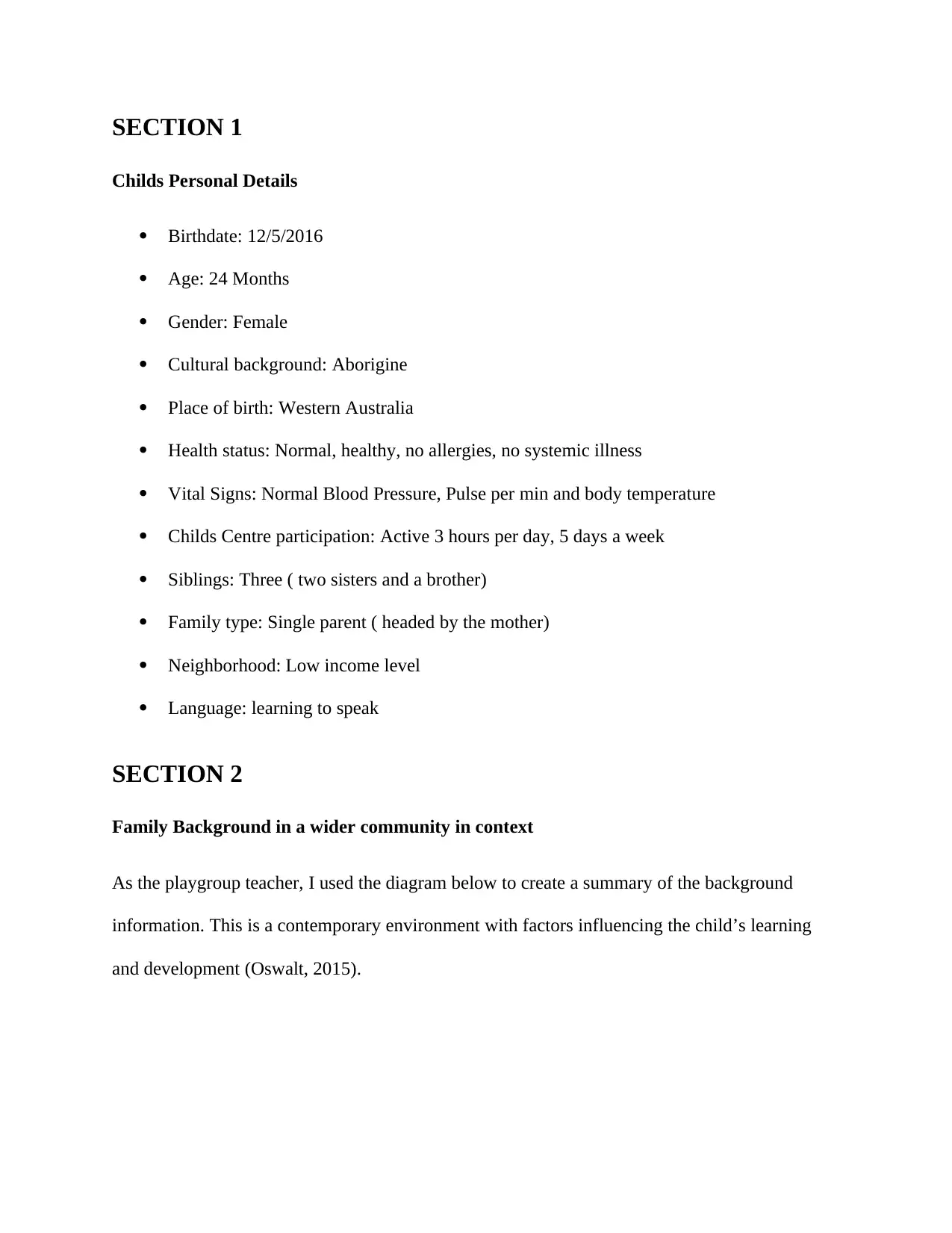
SECTION 1
Childs Personal Details
Birthdate: 12/5/2016
Age: 24 Months
Gender: Female
Cultural background: Aborigine
Place of birth: Western Australia
Health status: Normal, healthy, no allergies, no systemic illness
Vital Signs: Normal Blood Pressure, Pulse per min and body temperature
Childs Centre participation: Active 3 hours per day, 5 days a week
Siblings: Three ( two sisters and a brother)
Family type: Single parent ( headed by the mother)
Neighborhood: Low income level
Language: learning to speak
SECTION 2
Family Background in a wider community in context
As the playgroup teacher, I used the diagram below to create a summary of the background
information. This is a contemporary environment with factors influencing the child’s learning
and development (Oswalt, 2015).
Childs Personal Details
Birthdate: 12/5/2016
Age: 24 Months
Gender: Female
Cultural background: Aborigine
Place of birth: Western Australia
Health status: Normal, healthy, no allergies, no systemic illness
Vital Signs: Normal Blood Pressure, Pulse per min and body temperature
Childs Centre participation: Active 3 hours per day, 5 days a week
Siblings: Three ( two sisters and a brother)
Family type: Single parent ( headed by the mother)
Neighborhood: Low income level
Language: learning to speak
SECTION 2
Family Background in a wider community in context
As the playgroup teacher, I used the diagram below to create a summary of the background
information. This is a contemporary environment with factors influencing the child’s learning
and development (Oswalt, 2015).
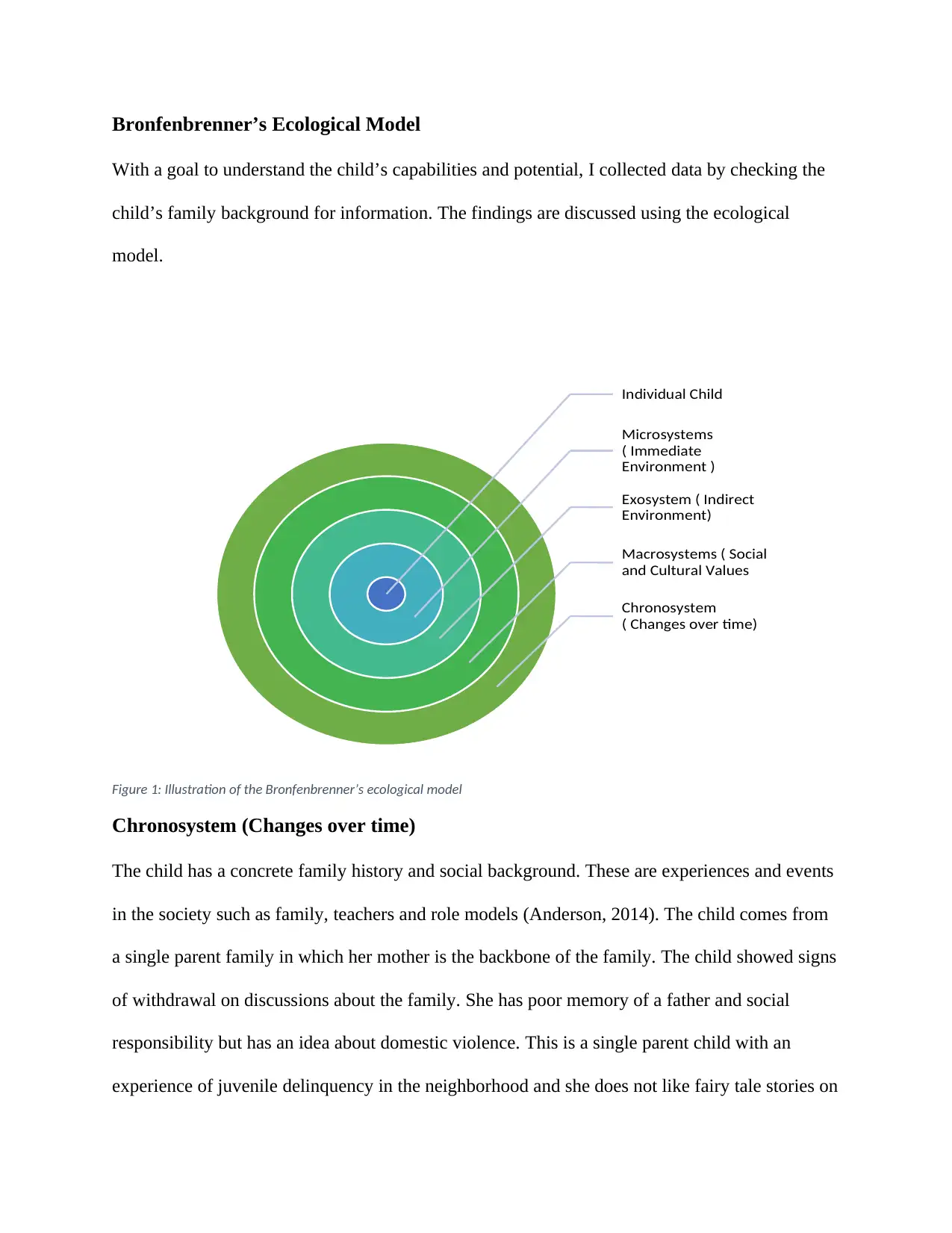
Bronfenbrenner’s Ecological Model
With a goal to understand the child’s capabilities and potential, I collected data by checking the
child’s family background for information. The findings are discussed using the ecological
model.
Figure 1: Illustration of the Bronfenbrenner’s ecological model
Chronosystem (Changes over time)
The child has a concrete family history and social background. These are experiences and events
in the society such as family, teachers and role models (Anderson, 2014). The child comes from
a single parent family in which her mother is the backbone of the family. The child showed signs
of withdrawal on discussions about the family. She has poor memory of a father and social
responsibility but has an idea about domestic violence. This is a single parent child with an
experience of juvenile delinquency in the neighborhood and she does not like fairy tale stories on
Individual Child
Microsystems
( Immediate
Environment )
Exosystem ( Indirect
Environment)
Macrosystems ( Social
and Cultural Values
Chronosystem
( Changes over time)
With a goal to understand the child’s capabilities and potential, I collected data by checking the
child’s family background for information. The findings are discussed using the ecological
model.
Figure 1: Illustration of the Bronfenbrenner’s ecological model
Chronosystem (Changes over time)
The child has a concrete family history and social background. These are experiences and events
in the society such as family, teachers and role models (Anderson, 2014). The child comes from
a single parent family in which her mother is the backbone of the family. The child showed signs
of withdrawal on discussions about the family. She has poor memory of a father and social
responsibility but has an idea about domestic violence. This is a single parent child with an
experience of juvenile delinquency in the neighborhood and she does not like fairy tale stories on
Individual Child
Microsystems
( Immediate
Environment )
Exosystem ( Indirect
Environment)
Macrosystems ( Social
and Cultural Values
Chronosystem
( Changes over time)
⊘ This is a preview!⊘
Do you want full access?
Subscribe today to unlock all pages.

Trusted by 1+ million students worldwide
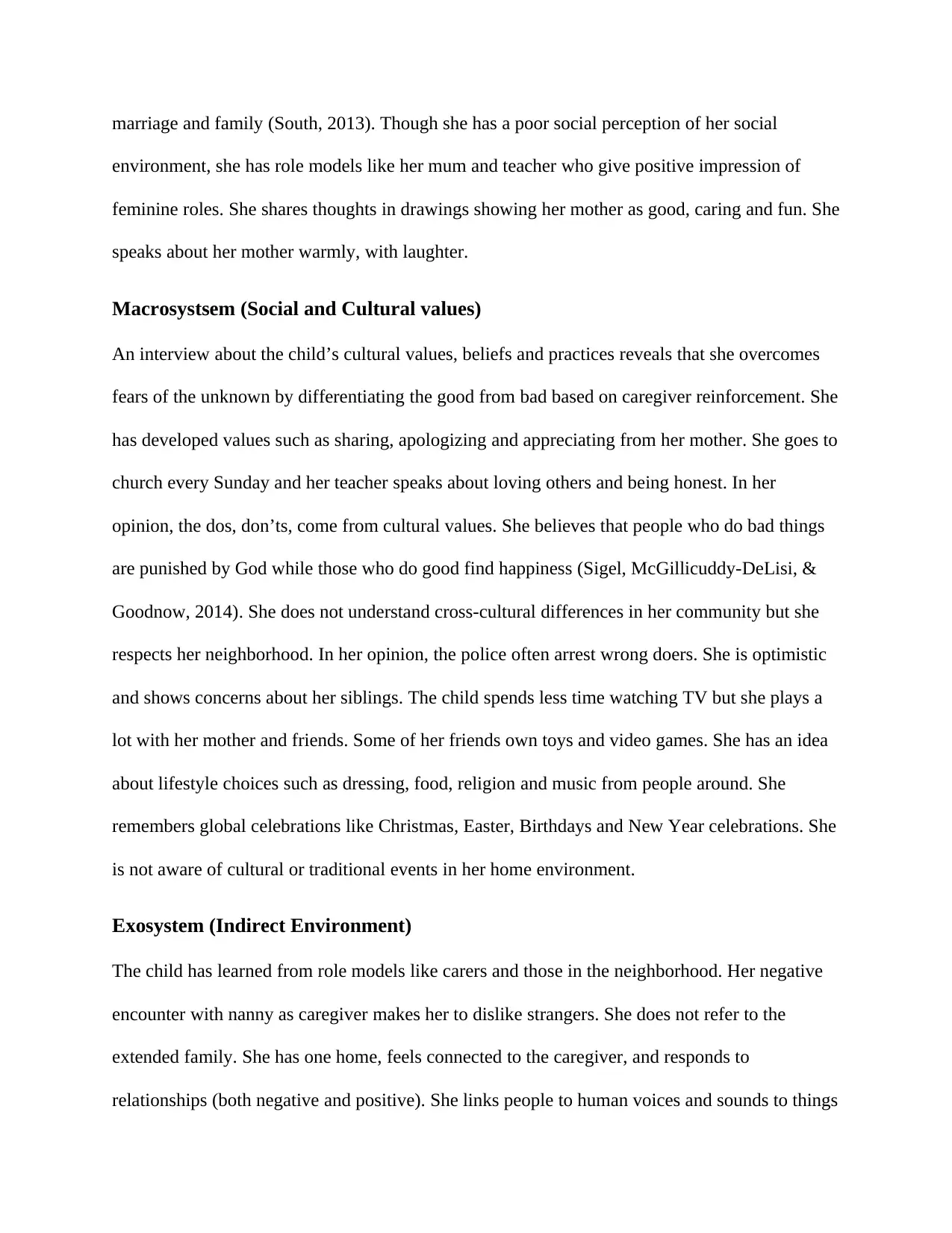
marriage and family (South, 2013). Though she has a poor social perception of her social
environment, she has role models like her mum and teacher who give positive impression of
feminine roles. She shares thoughts in drawings showing her mother as good, caring and fun. She
speaks about her mother warmly, with laughter.
Macrosystsem (Social and Cultural values)
An interview about the child’s cultural values, beliefs and practices reveals that she overcomes
fears of the unknown by differentiating the good from bad based on caregiver reinforcement. She
has developed values such as sharing, apologizing and appreciating from her mother. She goes to
church every Sunday and her teacher speaks about loving others and being honest. In her
opinion, the dos, don’ts, come from cultural values. She believes that people who do bad things
are punished by God while those who do good find happiness (Sigel, McGillicuddy-DeLisi, &
Goodnow, 2014). She does not understand cross-cultural differences in her community but she
respects her neighborhood. In her opinion, the police often arrest wrong doers. She is optimistic
and shows concerns about her siblings. The child spends less time watching TV but she plays a
lot with her mother and friends. Some of her friends own toys and video games. She has an idea
about lifestyle choices such as dressing, food, religion and music from people around. She
remembers global celebrations like Christmas, Easter, Birthdays and New Year celebrations. She
is not aware of cultural or traditional events in her home environment.
Exosystem (Indirect Environment)
The child has learned from role models like carers and those in the neighborhood. Her negative
encounter with nanny as caregiver makes her to dislike strangers. She does not refer to the
extended family. She has one home, feels connected to the caregiver, and responds to
relationships (both negative and positive). She links people to human voices and sounds to things
environment, she has role models like her mum and teacher who give positive impression of
feminine roles. She shares thoughts in drawings showing her mother as good, caring and fun. She
speaks about her mother warmly, with laughter.
Macrosystsem (Social and Cultural values)
An interview about the child’s cultural values, beliefs and practices reveals that she overcomes
fears of the unknown by differentiating the good from bad based on caregiver reinforcement. She
has developed values such as sharing, apologizing and appreciating from her mother. She goes to
church every Sunday and her teacher speaks about loving others and being honest. In her
opinion, the dos, don’ts, come from cultural values. She believes that people who do bad things
are punished by God while those who do good find happiness (Sigel, McGillicuddy-DeLisi, &
Goodnow, 2014). She does not understand cross-cultural differences in her community but she
respects her neighborhood. In her opinion, the police often arrest wrong doers. She is optimistic
and shows concerns about her siblings. The child spends less time watching TV but she plays a
lot with her mother and friends. Some of her friends own toys and video games. She has an idea
about lifestyle choices such as dressing, food, religion and music from people around. She
remembers global celebrations like Christmas, Easter, Birthdays and New Year celebrations. She
is not aware of cultural or traditional events in her home environment.
Exosystem (Indirect Environment)
The child has learned from role models like carers and those in the neighborhood. Her negative
encounter with nanny as caregiver makes her to dislike strangers. She does not refer to the
extended family. She has one home, feels connected to the caregiver, and responds to
relationships (both negative and positive). She links people to human voices and sounds to things
Paraphrase This Document
Need a fresh take? Get an instant paraphrase of this document with our AI Paraphraser
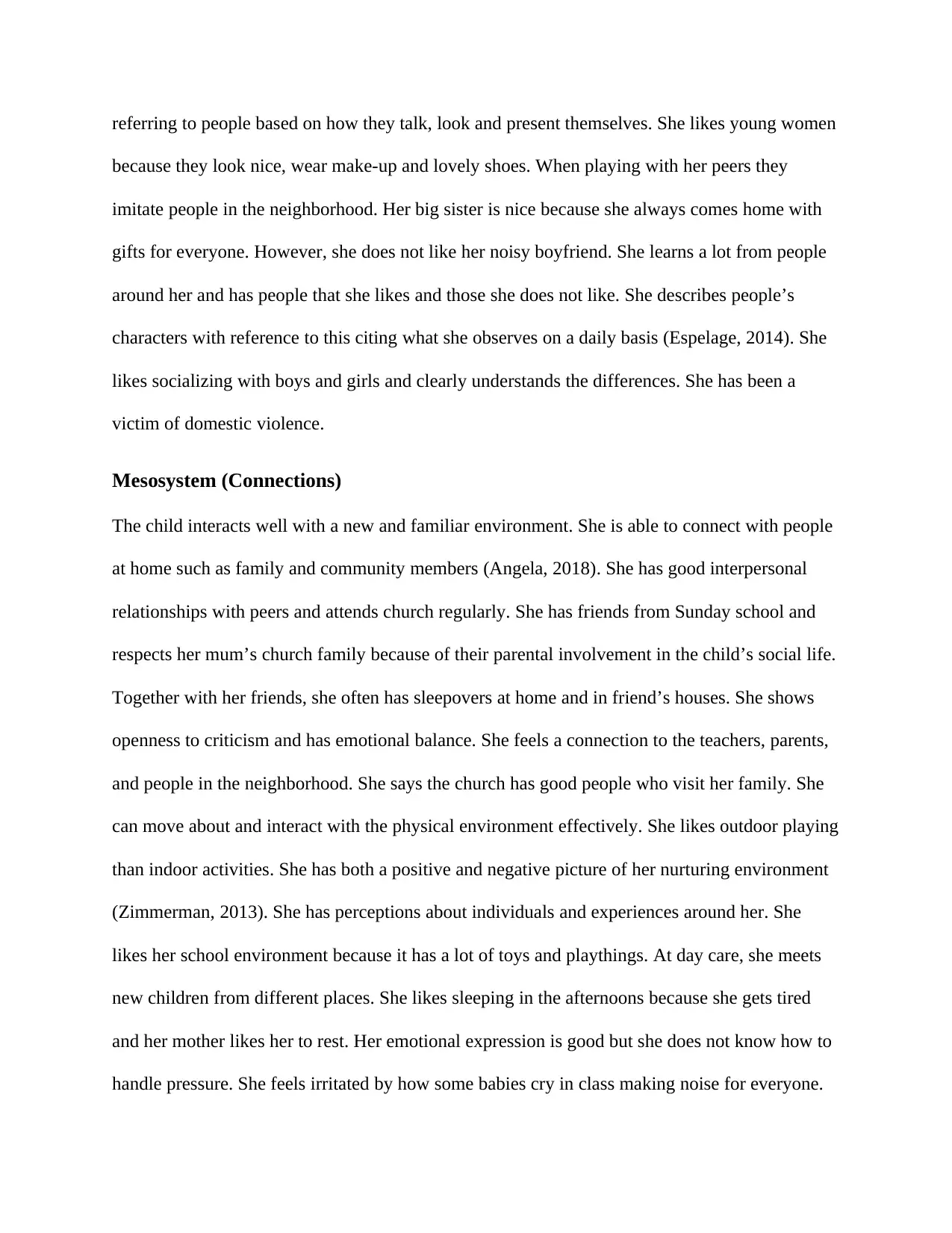
referring to people based on how they talk, look and present themselves. She likes young women
because they look nice, wear make-up and lovely shoes. When playing with her peers they
imitate people in the neighborhood. Her big sister is nice because she always comes home with
gifts for everyone. However, she does not like her noisy boyfriend. She learns a lot from people
around her and has people that she likes and those she does not like. She describes people’s
characters with reference to this citing what she observes on a daily basis (Espelage, 2014). She
likes socializing with boys and girls and clearly understands the differences. She has been a
victim of domestic violence.
Mesosystem (Connections)
The child interacts well with a new and familiar environment. She is able to connect with people
at home such as family and community members (Angela, 2018). She has good interpersonal
relationships with peers and attends church regularly. She has friends from Sunday school and
respects her mum’s church family because of their parental involvement in the child’s social life.
Together with her friends, she often has sleepovers at home and in friend’s houses. She shows
openness to criticism and has emotional balance. She feels a connection to the teachers, parents,
and people in the neighborhood. She says the church has good people who visit her family. She
can move about and interact with the physical environment effectively. She likes outdoor playing
than indoor activities. She has both a positive and negative picture of her nurturing environment
(Zimmerman, 2013). She has perceptions about individuals and experiences around her. She
likes her school environment because it has a lot of toys and playthings. At day care, she meets
new children from different places. She likes sleeping in the afternoons because she gets tired
and her mother likes her to rest. Her emotional expression is good but she does not know how to
handle pressure. She feels irritated by how some babies cry in class making noise for everyone.
because they look nice, wear make-up and lovely shoes. When playing with her peers they
imitate people in the neighborhood. Her big sister is nice because she always comes home with
gifts for everyone. However, she does not like her noisy boyfriend. She learns a lot from people
around her and has people that she likes and those she does not like. She describes people’s
characters with reference to this citing what she observes on a daily basis (Espelage, 2014). She
likes socializing with boys and girls and clearly understands the differences. She has been a
victim of domestic violence.
Mesosystem (Connections)
The child interacts well with a new and familiar environment. She is able to connect with people
at home such as family and community members (Angela, 2018). She has good interpersonal
relationships with peers and attends church regularly. She has friends from Sunday school and
respects her mum’s church family because of their parental involvement in the child’s social life.
Together with her friends, she often has sleepovers at home and in friend’s houses. She shows
openness to criticism and has emotional balance. She feels a connection to the teachers, parents,
and people in the neighborhood. She says the church has good people who visit her family. She
can move about and interact with the physical environment effectively. She likes outdoor playing
than indoor activities. She has both a positive and negative picture of her nurturing environment
(Zimmerman, 2013). She has perceptions about individuals and experiences around her. She
likes her school environment because it has a lot of toys and playthings. At day care, she meets
new children from different places. She likes sleeping in the afternoons because she gets tired
and her mother likes her to rest. Her emotional expression is good but she does not know how to
handle pressure. She feels irritated by how some babies cry in class making noise for everyone.
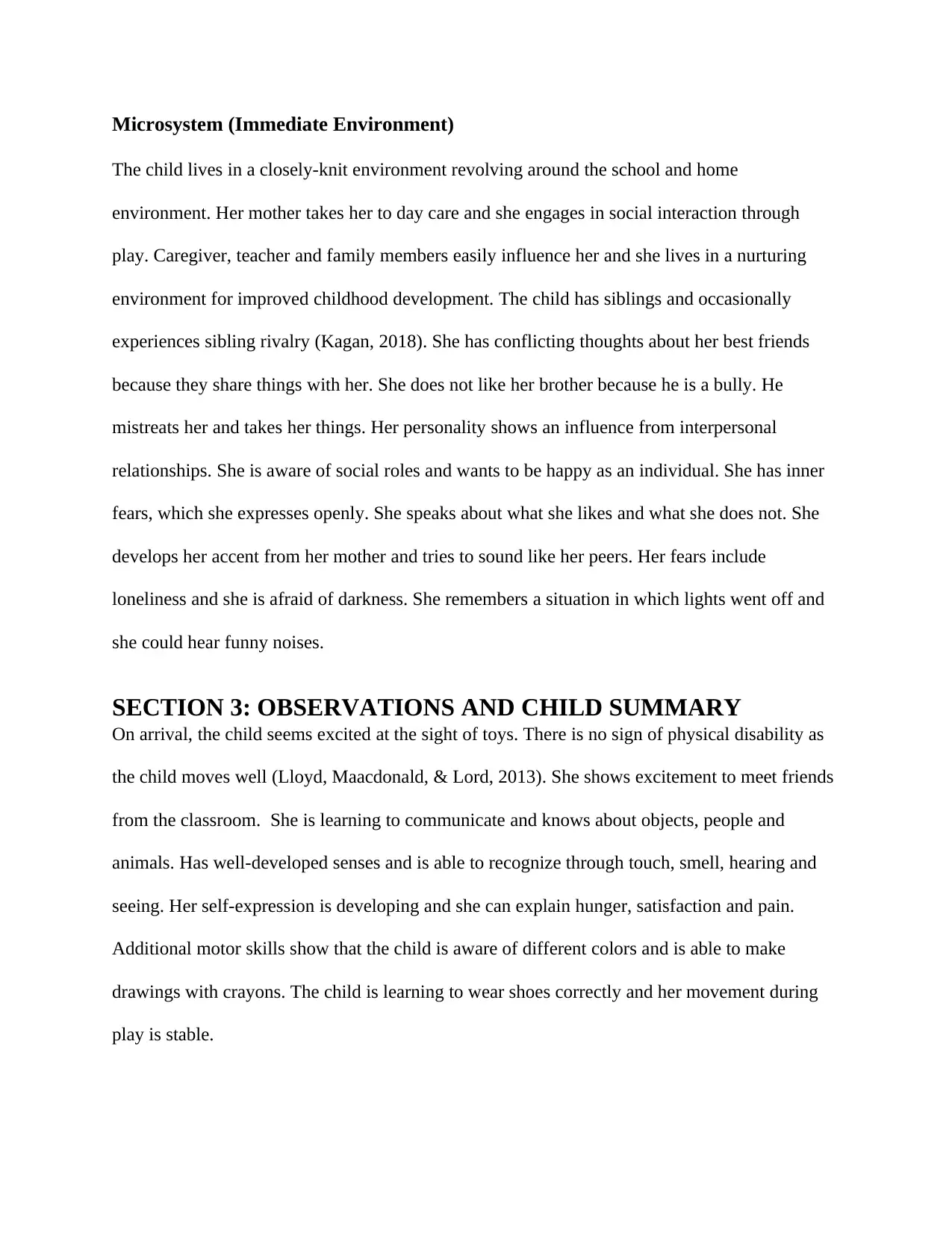
Microsystem (Immediate Environment)
The child lives in a closely-knit environment revolving around the school and home
environment. Her mother takes her to day care and she engages in social interaction through
play. Caregiver, teacher and family members easily influence her and she lives in a nurturing
environment for improved childhood development. The child has siblings and occasionally
experiences sibling rivalry (Kagan, 2018). She has conflicting thoughts about her best friends
because they share things with her. She does not like her brother because he is a bully. He
mistreats her and takes her things. Her personality shows an influence from interpersonal
relationships. She is aware of social roles and wants to be happy as an individual. She has inner
fears, which she expresses openly. She speaks about what she likes and what she does not. She
develops her accent from her mother and tries to sound like her peers. Her fears include
loneliness and she is afraid of darkness. She remembers a situation in which lights went off and
she could hear funny noises.
SECTION 3: OBSERVATIONS AND CHILD SUMMARY
On arrival, the child seems excited at the sight of toys. There is no sign of physical disability as
the child moves well (Lloyd, Maacdonald, & Lord, 2013). She shows excitement to meet friends
from the classroom. She is learning to communicate and knows about objects, people and
animals. Has well-developed senses and is able to recognize through touch, smell, hearing and
seeing. Her self-expression is developing and she can explain hunger, satisfaction and pain.
Additional motor skills show that the child is aware of different colors and is able to make
drawings with crayons. The child is learning to wear shoes correctly and her movement during
play is stable.
The child lives in a closely-knit environment revolving around the school and home
environment. Her mother takes her to day care and she engages in social interaction through
play. Caregiver, teacher and family members easily influence her and she lives in a nurturing
environment for improved childhood development. The child has siblings and occasionally
experiences sibling rivalry (Kagan, 2018). She has conflicting thoughts about her best friends
because they share things with her. She does not like her brother because he is a bully. He
mistreats her and takes her things. Her personality shows an influence from interpersonal
relationships. She is aware of social roles and wants to be happy as an individual. She has inner
fears, which she expresses openly. She speaks about what she likes and what she does not. She
develops her accent from her mother and tries to sound like her peers. Her fears include
loneliness and she is afraid of darkness. She remembers a situation in which lights went off and
she could hear funny noises.
SECTION 3: OBSERVATIONS AND CHILD SUMMARY
On arrival, the child seems excited at the sight of toys. There is no sign of physical disability as
the child moves well (Lloyd, Maacdonald, & Lord, 2013). She shows excitement to meet friends
from the classroom. She is learning to communicate and knows about objects, people and
animals. Has well-developed senses and is able to recognize through touch, smell, hearing and
seeing. Her self-expression is developing and she can explain hunger, satisfaction and pain.
Additional motor skills show that the child is aware of different colors and is able to make
drawings with crayons. The child is learning to wear shoes correctly and her movement during
play is stable.
⊘ This is a preview!⊘
Do you want full access?
Subscribe today to unlock all pages.

Trusted by 1+ million students worldwide
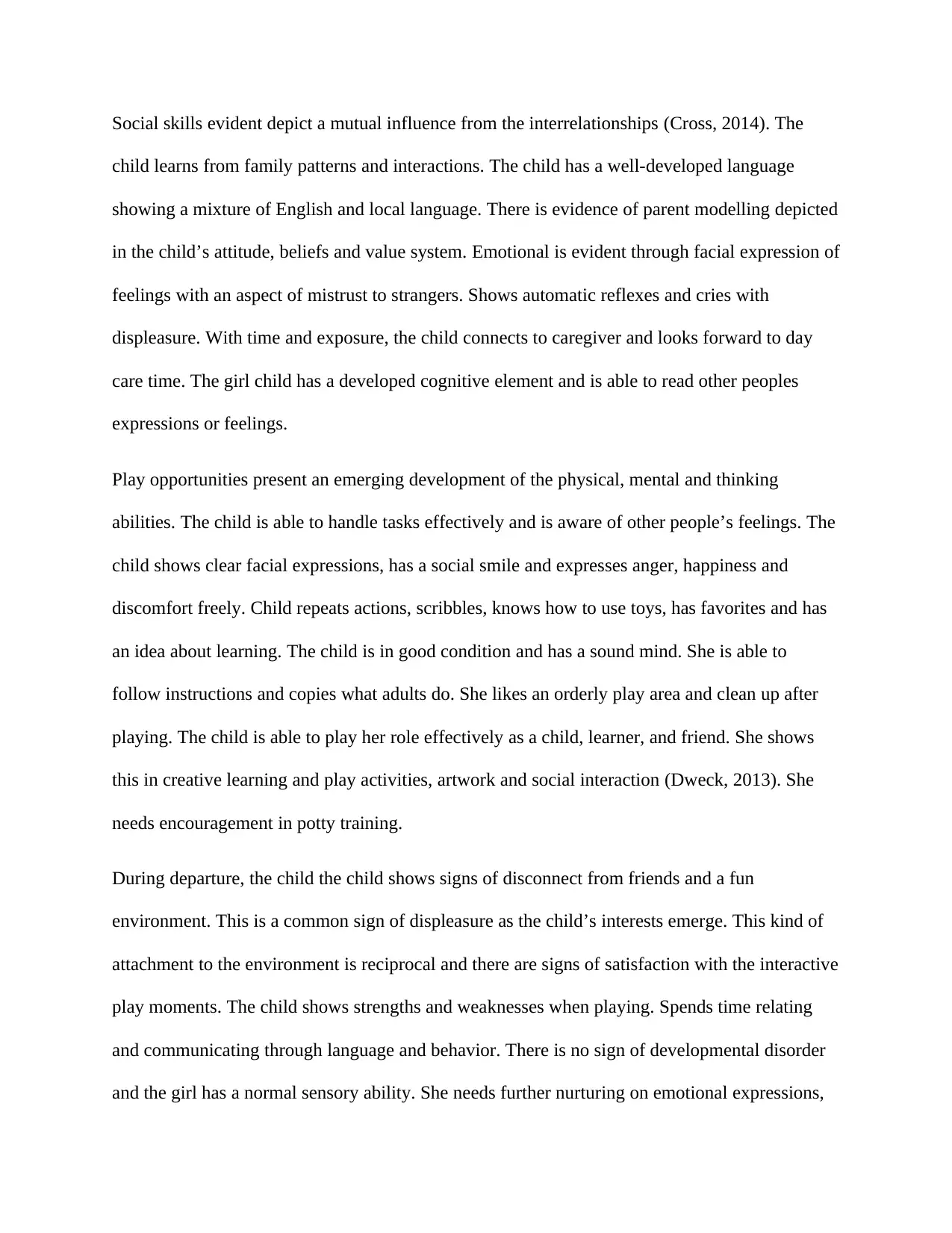
Social skills evident depict a mutual influence from the interrelationships (Cross, 2014). The
child learns from family patterns and interactions. The child has a well-developed language
showing a mixture of English and local language. There is evidence of parent modelling depicted
in the child’s attitude, beliefs and value system. Emotional is evident through facial expression of
feelings with an aspect of mistrust to strangers. Shows automatic reflexes and cries with
displeasure. With time and exposure, the child connects to caregiver and looks forward to day
care time. The girl child has a developed cognitive element and is able to read other peoples
expressions or feelings.
Play opportunities present an emerging development of the physical, mental and thinking
abilities. The child is able to handle tasks effectively and is aware of other people’s feelings. The
child shows clear facial expressions, has a social smile and expresses anger, happiness and
discomfort freely. Child repeats actions, scribbles, knows how to use toys, has favorites and has
an idea about learning. The child is in good condition and has a sound mind. She is able to
follow instructions and copies what adults do. She likes an orderly play area and clean up after
playing. The child is able to play her role effectively as a child, learner, and friend. She shows
this in creative learning and play activities, artwork and social interaction (Dweck, 2013). She
needs encouragement in potty training.
During departure, the child the child shows signs of disconnect from friends and a fun
environment. This is a common sign of displeasure as the child’s interests emerge. This kind of
attachment to the environment is reciprocal and there are signs of satisfaction with the interactive
play moments. The child shows strengths and weaknesses when playing. Spends time relating
and communicating through language and behavior. There is no sign of developmental disorder
and the girl has a normal sensory ability. She needs further nurturing on emotional expressions,
child learns from family patterns and interactions. The child has a well-developed language
showing a mixture of English and local language. There is evidence of parent modelling depicted
in the child’s attitude, beliefs and value system. Emotional is evident through facial expression of
feelings with an aspect of mistrust to strangers. Shows automatic reflexes and cries with
displeasure. With time and exposure, the child connects to caregiver and looks forward to day
care time. The girl child has a developed cognitive element and is able to read other peoples
expressions or feelings.
Play opportunities present an emerging development of the physical, mental and thinking
abilities. The child is able to handle tasks effectively and is aware of other people’s feelings. The
child shows clear facial expressions, has a social smile and expresses anger, happiness and
discomfort freely. Child repeats actions, scribbles, knows how to use toys, has favorites and has
an idea about learning. The child is in good condition and has a sound mind. She is able to
follow instructions and copies what adults do. She likes an orderly play area and clean up after
playing. The child is able to play her role effectively as a child, learner, and friend. She shows
this in creative learning and play activities, artwork and social interaction (Dweck, 2013). She
needs encouragement in potty training.
During departure, the child the child shows signs of disconnect from friends and a fun
environment. This is a common sign of displeasure as the child’s interests emerge. This kind of
attachment to the environment is reciprocal and there are signs of satisfaction with the interactive
play moments. The child shows strengths and weaknesses when playing. Spends time relating
and communicating through language and behavior. There is no sign of developmental disorder
and the girl has a normal sensory ability. She needs further nurturing on emotional expressions,
Paraphrase This Document
Need a fresh take? Get an instant paraphrase of this document with our AI Paraphraser
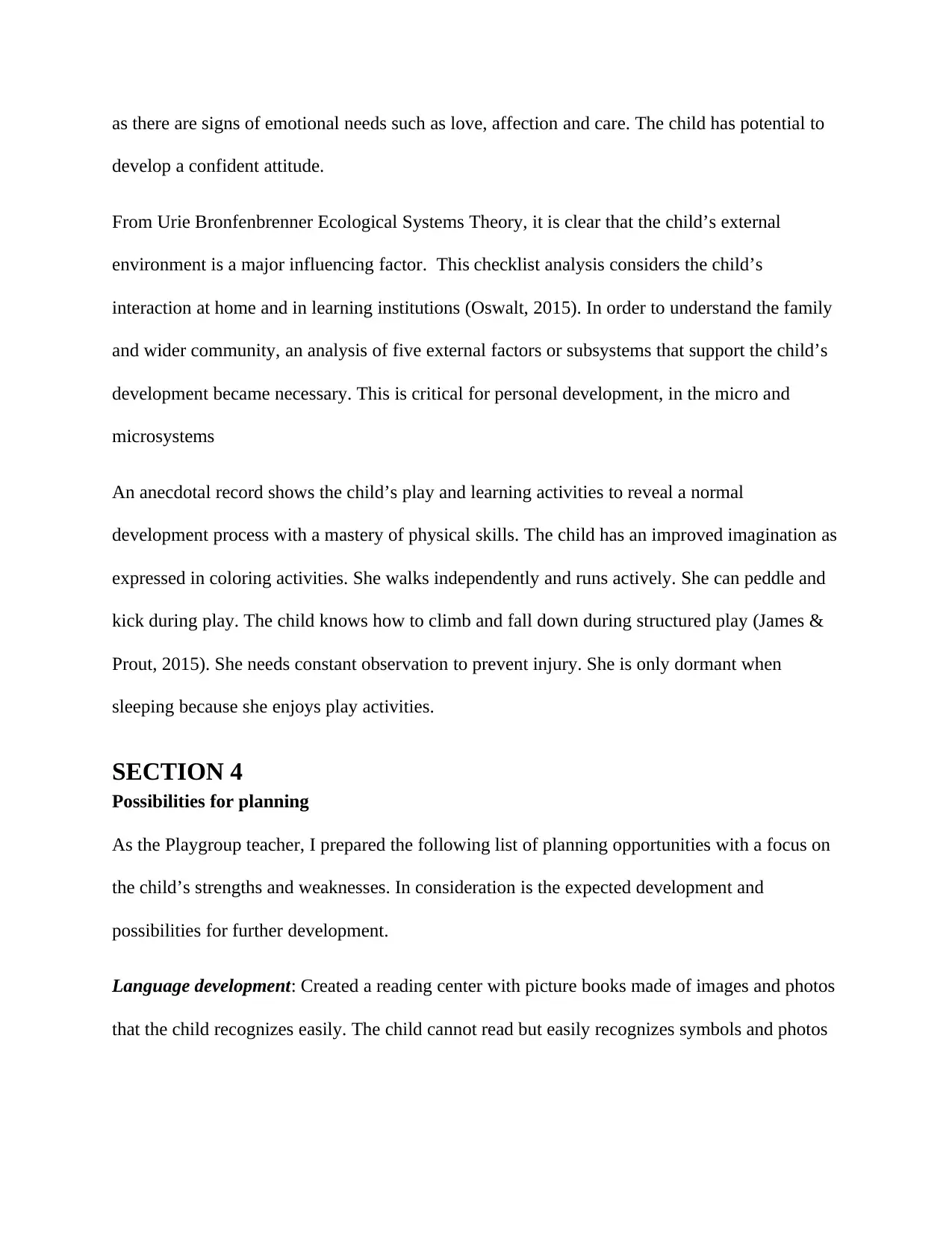
as there are signs of emotional needs such as love, affection and care. The child has potential to
develop a confident attitude.
From Urie Bronfenbrenner Ecological Systems Theory, it is clear that the child’s external
environment is a major influencing factor. This checklist analysis considers the child’s
interaction at home and in learning institutions (Oswalt, 2015). In order to understand the family
and wider community, an analysis of five external factors or subsystems that support the child’s
development became necessary. This is critical for personal development, in the micro and
microsystems
An anecdotal record shows the child’s play and learning activities to reveal a normal
development process with a mastery of physical skills. The child has an improved imagination as
expressed in coloring activities. She walks independently and runs actively. She can peddle and
kick during play. The child knows how to climb and fall down during structured play (James &
Prout, 2015). She needs constant observation to prevent injury. She is only dormant when
sleeping because she enjoys play activities.
SECTION 4
Possibilities for planning
As the Playgroup teacher, I prepared the following list of planning opportunities with a focus on
the child’s strengths and weaknesses. In consideration is the expected development and
possibilities for further development.
Language development: Created a reading center with picture books made of images and photos
that the child recognizes easily. The child cannot read but easily recognizes symbols and photos
develop a confident attitude.
From Urie Bronfenbrenner Ecological Systems Theory, it is clear that the child’s external
environment is a major influencing factor. This checklist analysis considers the child’s
interaction at home and in learning institutions (Oswalt, 2015). In order to understand the family
and wider community, an analysis of five external factors or subsystems that support the child’s
development became necessary. This is critical for personal development, in the micro and
microsystems
An anecdotal record shows the child’s play and learning activities to reveal a normal
development process with a mastery of physical skills. The child has an improved imagination as
expressed in coloring activities. She walks independently and runs actively. She can peddle and
kick during play. The child knows how to climb and fall down during structured play (James &
Prout, 2015). She needs constant observation to prevent injury. She is only dormant when
sleeping because she enjoys play activities.
SECTION 4
Possibilities for planning
As the Playgroup teacher, I prepared the following list of planning opportunities with a focus on
the child’s strengths and weaknesses. In consideration is the expected development and
possibilities for further development.
Language development: Created a reading center with picture books made of images and photos
that the child recognizes easily. The child cannot read but easily recognizes symbols and photos
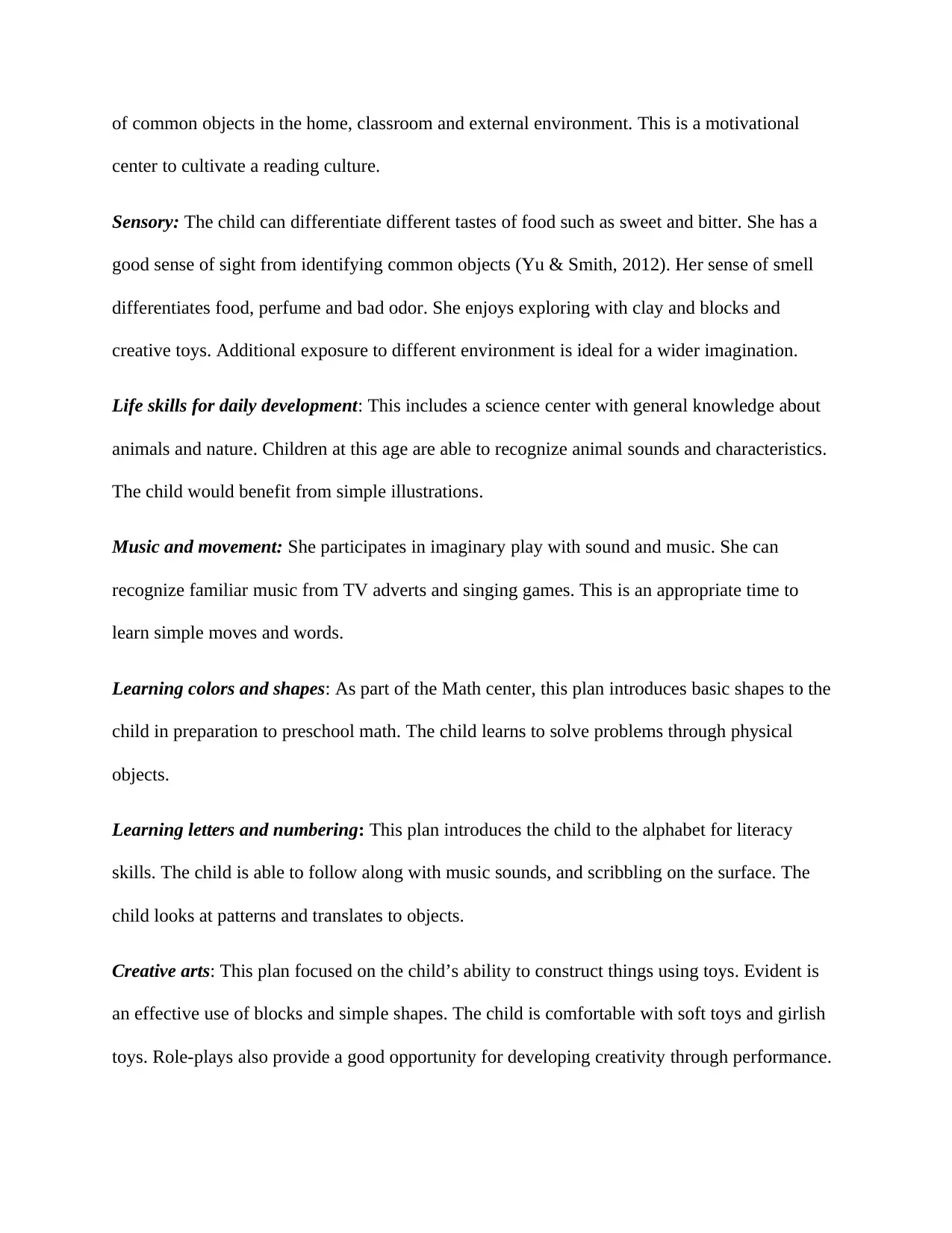
of common objects in the home, classroom and external environment. This is a motivational
center to cultivate a reading culture.
Sensory: The child can differentiate different tastes of food such as sweet and bitter. She has a
good sense of sight from identifying common objects (Yu & Smith, 2012). Her sense of smell
differentiates food, perfume and bad odor. She enjoys exploring with clay and blocks and
creative toys. Additional exposure to different environment is ideal for a wider imagination.
Life skills for daily development: This includes a science center with general knowledge about
animals and nature. Children at this age are able to recognize animal sounds and characteristics.
The child would benefit from simple illustrations.
Music and movement: She participates in imaginary play with sound and music. She can
recognize familiar music from TV adverts and singing games. This is an appropriate time to
learn simple moves and words.
Learning colors and shapes: As part of the Math center, this plan introduces basic shapes to the
child in preparation to preschool math. The child learns to solve problems through physical
objects.
Learning letters and numbering: This plan introduces the child to the alphabet for literacy
skills. The child is able to follow along with music sounds, and scribbling on the surface. The
child looks at patterns and translates to objects.
Creative arts: This plan focused on the child’s ability to construct things using toys. Evident is
an effective use of blocks and simple shapes. The child is comfortable with soft toys and girlish
toys. Role-plays also provide a good opportunity for developing creativity through performance.
center to cultivate a reading culture.
Sensory: The child can differentiate different tastes of food such as sweet and bitter. She has a
good sense of sight from identifying common objects (Yu & Smith, 2012). Her sense of smell
differentiates food, perfume and bad odor. She enjoys exploring with clay and blocks and
creative toys. Additional exposure to different environment is ideal for a wider imagination.
Life skills for daily development: This includes a science center with general knowledge about
animals and nature. Children at this age are able to recognize animal sounds and characteristics.
The child would benefit from simple illustrations.
Music and movement: She participates in imaginary play with sound and music. She can
recognize familiar music from TV adverts and singing games. This is an appropriate time to
learn simple moves and words.
Learning colors and shapes: As part of the Math center, this plan introduces basic shapes to the
child in preparation to preschool math. The child learns to solve problems through physical
objects.
Learning letters and numbering: This plan introduces the child to the alphabet for literacy
skills. The child is able to follow along with music sounds, and scribbling on the surface. The
child looks at patterns and translates to objects.
Creative arts: This plan focused on the child’s ability to construct things using toys. Evident is
an effective use of blocks and simple shapes. The child is comfortable with soft toys and girlish
toys. Role-plays also provide a good opportunity for developing creativity through performance.
⊘ This is a preview!⊘
Do you want full access?
Subscribe today to unlock all pages.

Trusted by 1+ million students worldwide
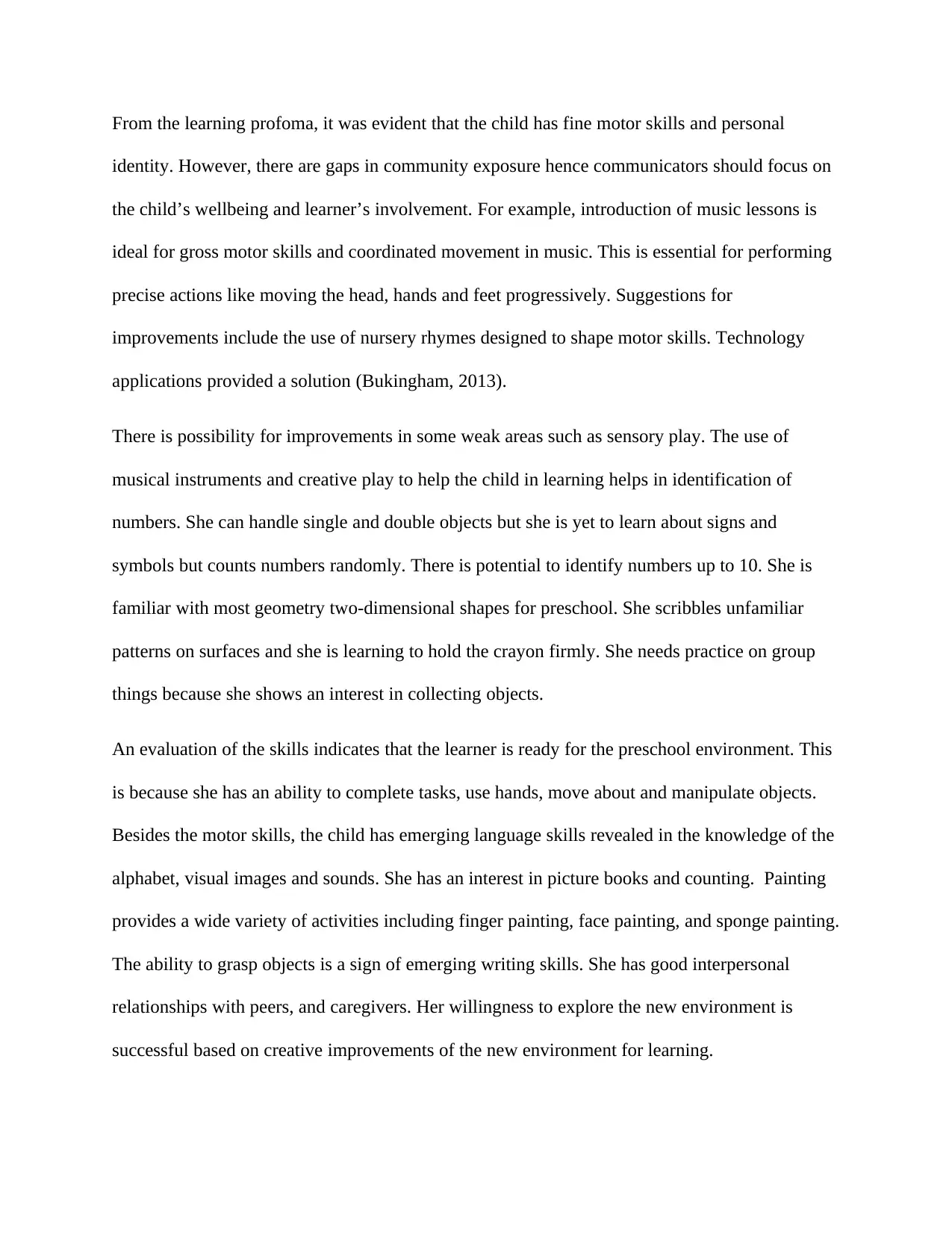
From the learning profoma, it was evident that the child has fine motor skills and personal
identity. However, there are gaps in community exposure hence communicators should focus on
the child’s wellbeing and learner’s involvement. For example, introduction of music lessons is
ideal for gross motor skills and coordinated movement in music. This is essential for performing
precise actions like moving the head, hands and feet progressively. Suggestions for
improvements include the use of nursery rhymes designed to shape motor skills. Technology
applications provided a solution (Bukingham, 2013).
There is possibility for improvements in some weak areas such as sensory play. The use of
musical instruments and creative play to help the child in learning helps in identification of
numbers. She can handle single and double objects but she is yet to learn about signs and
symbols but counts numbers randomly. There is potential to identify numbers up to 10. She is
familiar with most geometry two-dimensional shapes for preschool. She scribbles unfamiliar
patterns on surfaces and she is learning to hold the crayon firmly. She needs practice on group
things because she shows an interest in collecting objects.
An evaluation of the skills indicates that the learner is ready for the preschool environment. This
is because she has an ability to complete tasks, use hands, move about and manipulate objects.
Besides the motor skills, the child has emerging language skills revealed in the knowledge of the
alphabet, visual images and sounds. She has an interest in picture books and counting. Painting
provides a wide variety of activities including finger painting, face painting, and sponge painting.
The ability to grasp objects is a sign of emerging writing skills. She has good interpersonal
relationships with peers, and caregivers. Her willingness to explore the new environment is
successful based on creative improvements of the new environment for learning.
identity. However, there are gaps in community exposure hence communicators should focus on
the child’s wellbeing and learner’s involvement. For example, introduction of music lessons is
ideal for gross motor skills and coordinated movement in music. This is essential for performing
precise actions like moving the head, hands and feet progressively. Suggestions for
improvements include the use of nursery rhymes designed to shape motor skills. Technology
applications provided a solution (Bukingham, 2013).
There is possibility for improvements in some weak areas such as sensory play. The use of
musical instruments and creative play to help the child in learning helps in identification of
numbers. She can handle single and double objects but she is yet to learn about signs and
symbols but counts numbers randomly. There is potential to identify numbers up to 10. She is
familiar with most geometry two-dimensional shapes for preschool. She scribbles unfamiliar
patterns on surfaces and she is learning to hold the crayon firmly. She needs practice on group
things because she shows an interest in collecting objects.
An evaluation of the skills indicates that the learner is ready for the preschool environment. This
is because she has an ability to complete tasks, use hands, move about and manipulate objects.
Besides the motor skills, the child has emerging language skills revealed in the knowledge of the
alphabet, visual images and sounds. She has an interest in picture books and counting. Painting
provides a wide variety of activities including finger painting, face painting, and sponge painting.
The ability to grasp objects is a sign of emerging writing skills. She has good interpersonal
relationships with peers, and caregivers. Her willingness to explore the new environment is
successful based on creative improvements of the new environment for learning.
Paraphrase This Document
Need a fresh take? Get an instant paraphrase of this document with our AI Paraphraser
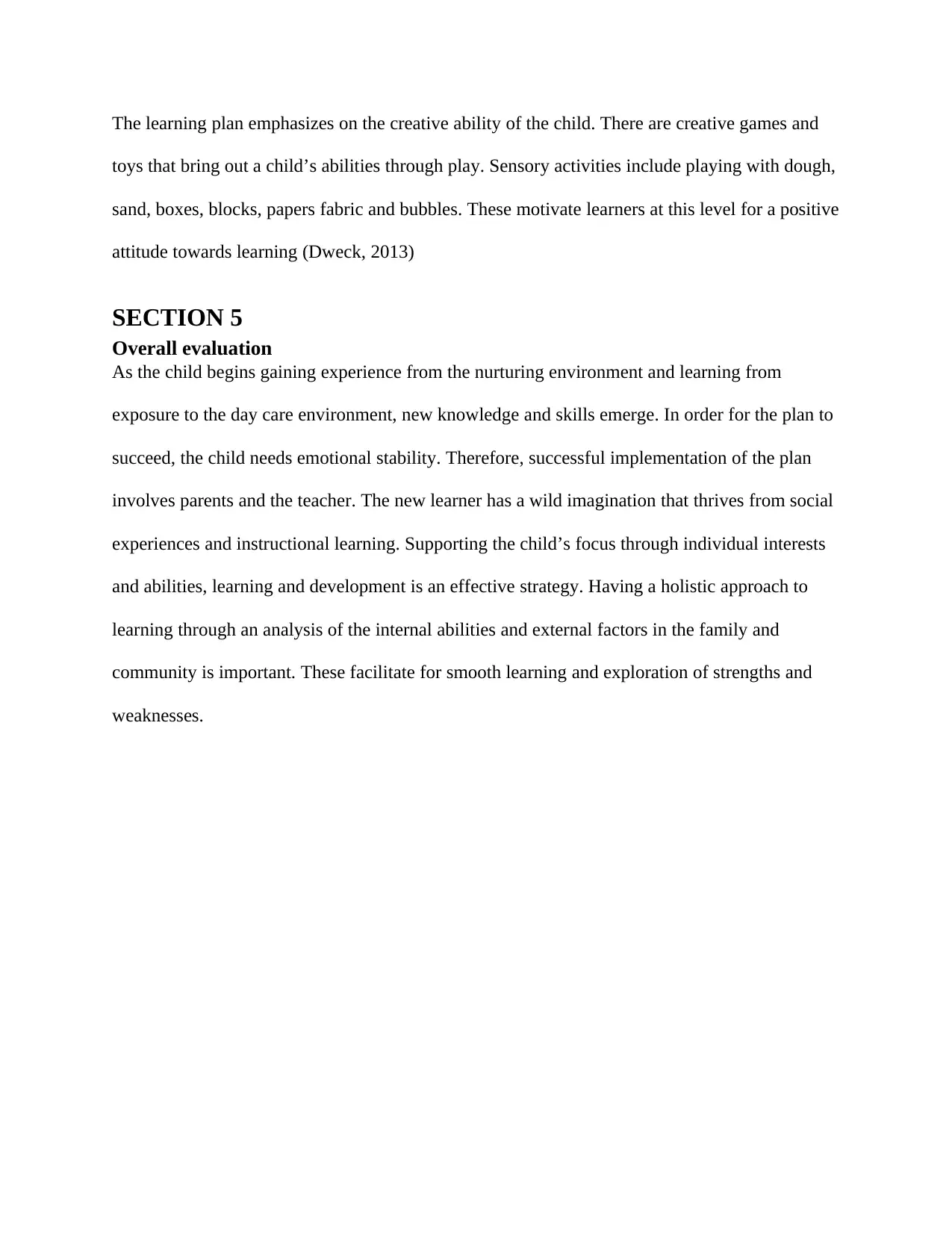
The learning plan emphasizes on the creative ability of the child. There are creative games and
toys that bring out a child’s abilities through play. Sensory activities include playing with dough,
sand, boxes, blocks, papers fabric and bubbles. These motivate learners at this level for a positive
attitude towards learning (Dweck, 2013)
SECTION 5
Overall evaluation
As the child begins gaining experience from the nurturing environment and learning from
exposure to the day care environment, new knowledge and skills emerge. In order for the plan to
succeed, the child needs emotional stability. Therefore, successful implementation of the plan
involves parents and the teacher. The new learner has a wild imagination that thrives from social
experiences and instructional learning. Supporting the child’s focus through individual interests
and abilities, learning and development is an effective strategy. Having a holistic approach to
learning through an analysis of the internal abilities and external factors in the family and
community is important. These facilitate for smooth learning and exploration of strengths and
weaknesses.
toys that bring out a child’s abilities through play. Sensory activities include playing with dough,
sand, boxes, blocks, papers fabric and bubbles. These motivate learners at this level for a positive
attitude towards learning (Dweck, 2013)
SECTION 5
Overall evaluation
As the child begins gaining experience from the nurturing environment and learning from
exposure to the day care environment, new knowledge and skills emerge. In order for the plan to
succeed, the child needs emotional stability. Therefore, successful implementation of the plan
involves parents and the teacher. The new learner has a wild imagination that thrives from social
experiences and instructional learning. Supporting the child’s focus through individual interests
and abilities, learning and development is an effective strategy. Having a holistic approach to
learning through an analysis of the internal abilities and external factors in the family and
community is important. These facilitate for smooth learning and exploration of strengths and
weaknesses.
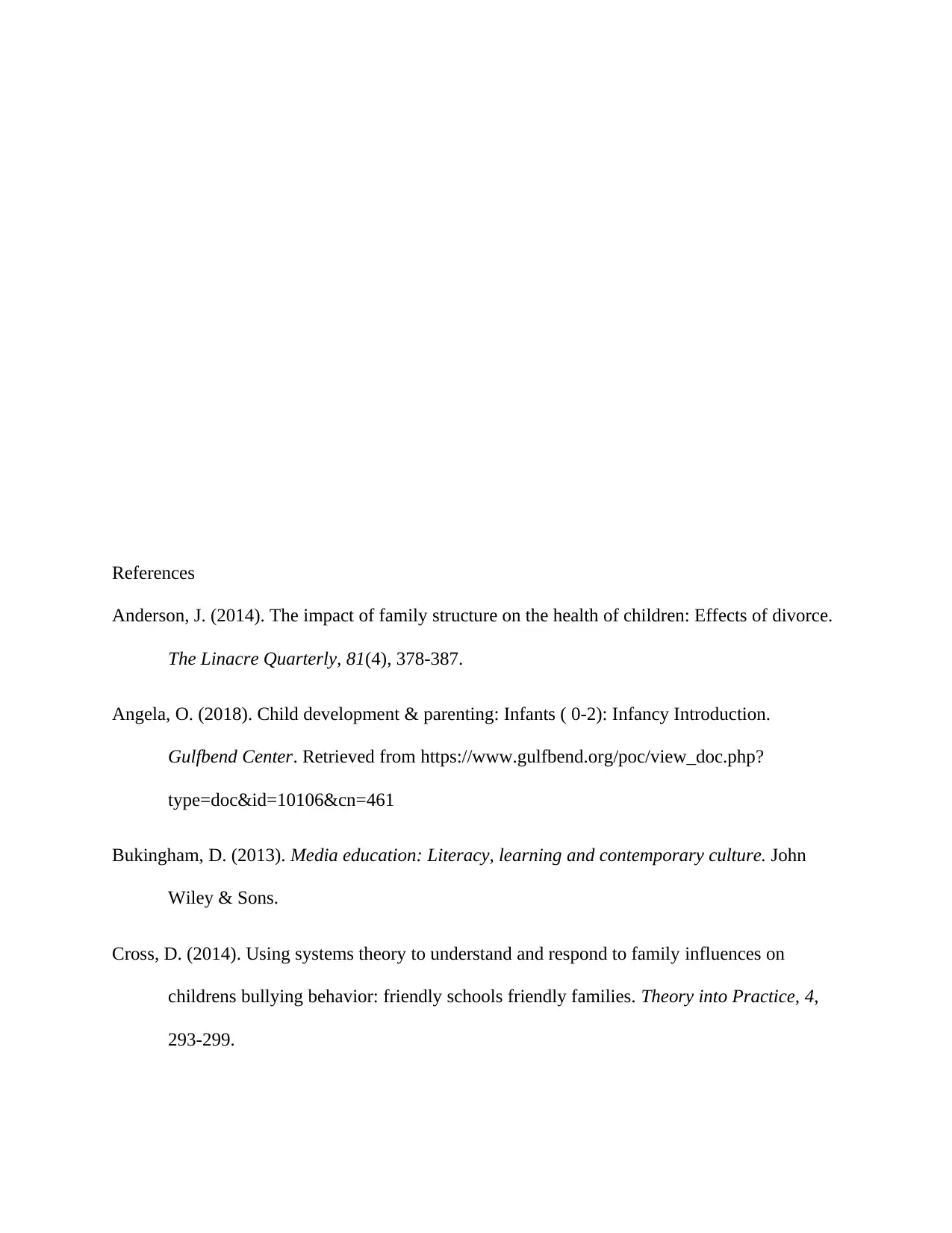
References
Anderson, J. (2014). The impact of family structure on the health of children: Effects of divorce.
The Linacre Quarterly, 81(4), 378-387.
Angela, O. (2018). Child development & parenting: Infants ( 0-2): Infancy Introduction.
Gulfbend Center. Retrieved from https://www.gulfbend.org/poc/view_doc.php?
type=doc&id=10106&cn=461
Bukingham, D. (2013). Media education: Literacy, learning and contemporary culture. John
Wiley & Sons.
Cross, D. (2014). Using systems theory to understand and respond to family influences on
childrens bullying behavior: friendly schools friendly families. Theory into Practice, 4,
293-299.
Anderson, J. (2014). The impact of family structure on the health of children: Effects of divorce.
The Linacre Quarterly, 81(4), 378-387.
Angela, O. (2018). Child development & parenting: Infants ( 0-2): Infancy Introduction.
Gulfbend Center. Retrieved from https://www.gulfbend.org/poc/view_doc.php?
type=doc&id=10106&cn=461
Bukingham, D. (2013). Media education: Literacy, learning and contemporary culture. John
Wiley & Sons.
Cross, D. (2014). Using systems theory to understand and respond to family influences on
childrens bullying behavior: friendly schools friendly families. Theory into Practice, 4,
293-299.
⊘ This is a preview!⊘
Do you want full access?
Subscribe today to unlock all pages.

Trusted by 1+ million students worldwide
1 out of 14
Related Documents
Your All-in-One AI-Powered Toolkit for Academic Success.
+13062052269
info@desklib.com
Available 24*7 on WhatsApp / Email
![[object Object]](/_next/static/media/star-bottom.7253800d.svg)
Unlock your academic potential
Copyright © 2020–2025 A2Z Services. All Rights Reserved. Developed and managed by ZUCOL.





